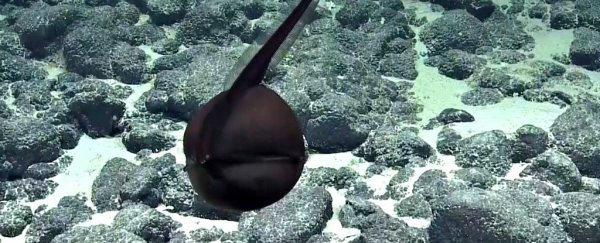Papahanaumokuakea Marine National Monument, the nation's largest protected area, stretches over half-a-million square miles of sea and land in Hawaii. It also includes wonderfully odd and stretchy critters, as a research team aboard the exploration vessel Nautilus observed Thursday.
The Nautilus, operated by the nonprofit Ocean Exploration Trust, has been streaming excursions online since 2012. (The Nautilus team showed us, in 2016, a mysterious purple orb of deep-sea jelly.) Again, the team has spotted something bizarre – an inflatable animal that lives 4,600 feet below the Pacific surface.

The video is a treat, with the research crew's Greek chorus narrating the moment of discovery:
"Looks like a Muppet."
"What are you?"
"Huh."
"Oh. Oh, it's a fish!"
"That's a fish – what?"
The fish contorts, rippling like a balloon with a leak. The scientists continue in their delight and puzzlement.
"Is it engorged or is it — like that?"
Once it opens its mouth, revealing huge jaws, the fish is pegged for what it is:
"Is that a gulper eel, then?"
The scientific name for the gulper eel is Eurypharynx pelecanoides. Like its namesake pelicans, the eel can scoop up large prey in its jaws. It might also stretch out its mouth into a net when hunting fish, crustaceans and squid.
In a flash, the gulper eel deflated and swam away. "That," one of the scientists says in the video, "was awesome."
Thomas Hourigan, who studies deepwater coral at the National Oceanic and Atmospheric Administration and is one of the lead scientists on the current Nautilus expedition, told The Washington Post that this ecosystem is "pristine," protected from deep-sea fishing methods like trawling.
The scientists are trying to understand the geology of the region's sea mounts and describe the organisms that live there.
"We had been photographing and videotaping the deep-sea coral habitats, and that's when we observed this strange balloon creature with a tail. It was totally unexpected," he said.
This gulper eel's underwater twirls were a rare sight. "Almost any time we dive we're finding something new and exceptional," Hourigan said.
The current expedition will continue to be streamed at NautilusLive.org until Oct. 2.
2018 © The Washington Post
This article was originally published by The Washington Post.
